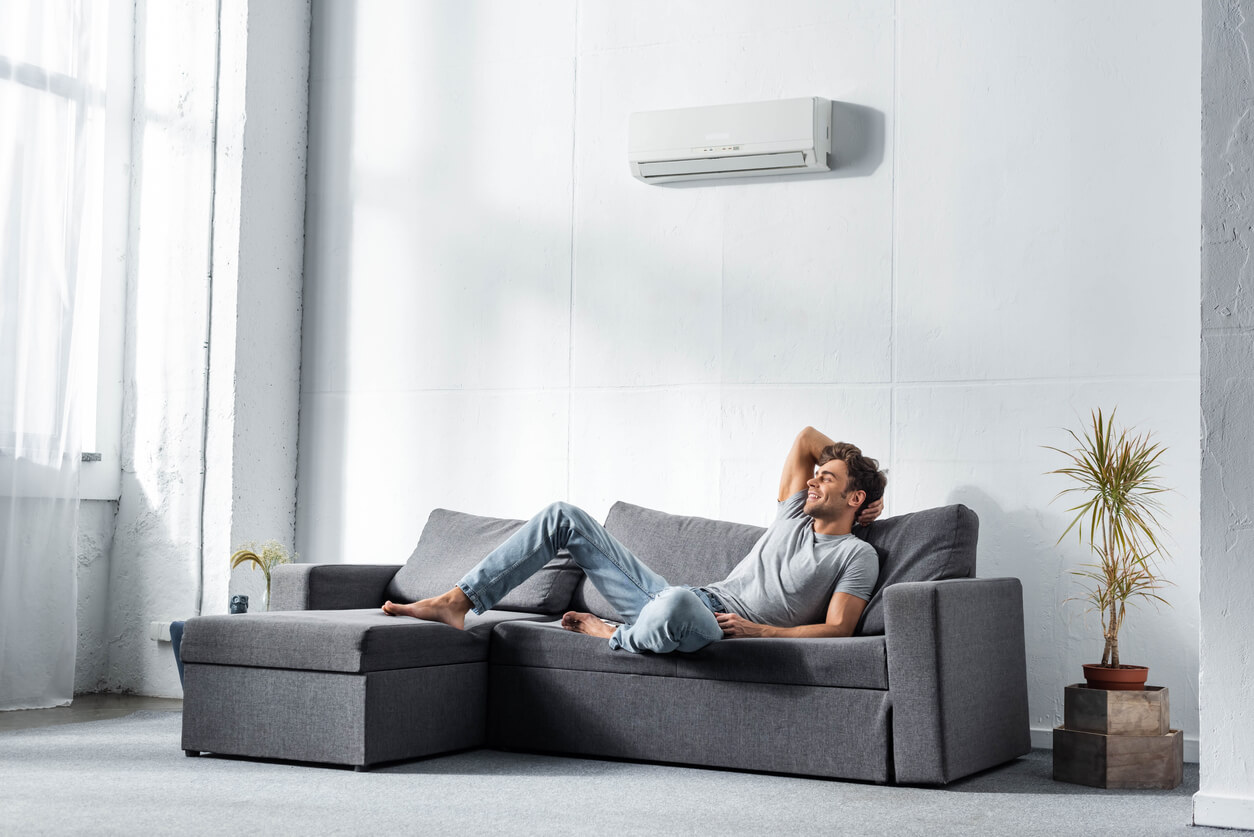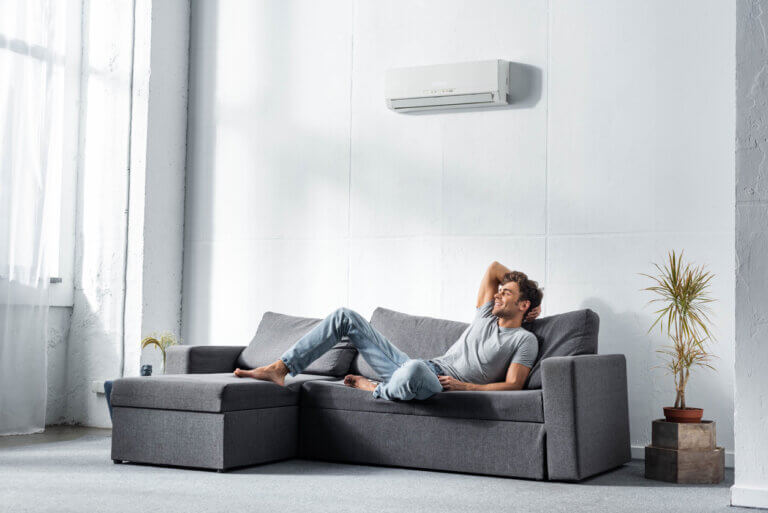Selecting the right air conditioning system is necessary for a pleasant living or working environment, especially in areas with extreme seasonal temperatures.
The decision often narrows to two popular options: central air conditioning and ductless (mini-split) systems. Each type has its own set of features, benefits, and considerations.
Whether installing a new AC system, upgrading your current setup, or searching for the most sustainable option, we’ve got you covered.
Read our guide for a thorough comparison between central and ductless air conditioning systems, or contact Season Control HVAC at (818) 495-6719 to learn more.
Understanding Central Air Conditioning Systems
Central air conditioning systems can cool entire buildings or homes uniformly and efficiently.
These systems circulate cool air through ducts and vents, reaching every room for consistent comfort.
The core components of a central air system include:
- the outdoor unit (housing the compressor and condenser)
- the indoor unit (usually combined with the furnace or air handler)
- the ductwork that distributes air throughout the space
Advantages of Central Air Conditioning
Whole Home Comfort
Central air conditioning system provides consistent cooling throughout the entire building or home. Unlike standalone units that only cool one room at a time, central AC gives every space the same comfortable temperature.
The uniform cooling is especially beneficial for large homes or spaces with multiple rooms, as it eliminates hot spots and maintains a stable environment.
Advanced Air Filtration
Central AC units have advanced air filtration systems to capture dust, pollen, pet dander, and other airborne pollutants. This allows only clean and healthy air to circulate through the room.
Aesthetic and Space Efficient
The central AC system’s design is less visible than its counterparts. Most components can be installed outdoors or in basements, attics, or closets, out of sight.
You can also design the visible parts, such as vents and thermostats, to blend with the interior for an aesthetic appearance.
Integrated Heating and Cooling
Many central air systems are part of a larger HVAC (Heating, Ventilation, and Air Conditioning) system that can heat and cool a space.
This means homeowners can switch between heating and cooling functions without requiring separate systems. It also simplifies the installation and maintenance process, thus potentially reducing costs.
Challenges of a Central Air Conditioning System
- Installation Complexity: Retrofitting ductwork in homes without existing ducts can be invasive, expensive, and time-consuming.
- Higher Initial Investment: The upfront costs for purchasing and installing a central air system, including ductwork, are typically higher than for ductless systems.
- Energy Efficiency Considerations: Central air conditioning may lead to higher operational costs, especially when cooling large or unused spaces, due to its higher energy consumption.
- Maintenance Requirements: Central systems require regular maintenance, including duct cleaning and filter replacements, to maintain efficiency and air quality.
- Air Leakage and Loss: Potential for air leakage through ducts, leading to loss of cool air and decreased system efficiency, necessitating additional energy to maintain desired temperatures.
- Space Requirements for Ducts: Installing ductwork requires physical space, which can be challenging in homes with limited space or that wish to preserve certain architectural elements.
Understanding Ductless Air Conditioning System
Ductless air conditioning systems or mini-split systems cool specific areas or “zones” without requiring extensive ductwork. They are ideal for spaces where ducts might not be feasible or for supplementing existing cooling systems.
The core components of a ductless air conditioning system include:
- Outdoor Unit: Similar to central systems, the outdoor unit houses the compressor and condenser.
- Indoor Units: Compact air handlers that can be mounted on walls, ceilings, or floors. Each unit is responsible for cooling a specific zone.
- Refrigerant Lines: Connect the outdoor unit to each indoor unit, allowing the refrigerant to circulate and cool the air.
Advantages of Ductless Air Conditioning
Flexible Installation
Ductless systems have a straightforward and adaptable installation process. They are ideal for older or historic buildings where installing traditional ductwork is impractical or disruptive.
You can also install them in new spaces where existing HVAC systems are only feasible with structural changes.
Energy Efficiency
Ductless mini-split systems cool only the areas that require them. These systems minimize waste, leading to lower energy consumption and cost savings.
Advanced technologies like inverter compressors adjust the operation speed to the demand, further improving their functionality.
Individual Zoning
Ductless air conditioning allows precise control over the climate in different areas or zones within a space.
This means that the temperature in each room can be adjusted to suit the occupant’s comfort levels and needs.
Reduced Energy Loss
Ductless systems avoid the energy loss associated with duct leakage and insulation issues, common in traditional HVAC systems.
This direct approach to cooling ensures more efficient use of energy and significantly lowers operational costs over time.
Improved Air Quality
The advanced filtration systems reduce dust, allergens, and other airborne pollutants.
The easy-to-access filters also simplify routine maintenance to provide users with healthy air quality and environment.
Challenges of Ductless Air Conditioning Systems
- Higher Initial Cost per Zone: The upfront investment for a ductless system, particularly for multiple zones, can be higher than that of central air conditioning.
- Aesthetic Considerations: Indoor units may not blend seamlessly into every decor, requiring thoughtful placement to minimize visual impact.
- Limited Heating Capability: In colder climates, the heating function of ductless systems may not suffice, potentially necessitating additional heat sources.
- Installation Location Constraints: Strategic placement is crucial for optimal cooling efficiency, which might limit installation options.
- Requires Exterior Wall Space: Each indoor unit needs to connect to an outdoor unit, which is challenging for properties with limited outdoor space.
- Maintenance of Multiple Units: Homes with several indoor units will face a higher maintenance burden, including regular filter cleaning and servicing.
Making the Right Choice: Central vs. Ductless Air Conditioning
The choice between central and ductless systems involves weighing several critical factors. Here’s a guide to ensure your cooling needs are met efficiently with the right system.
Consider Your Space
Central Systems are best for cooling entire homes or larger spaces uniformly. If your property already has ductwork, upgrading to a modern central air system could be a straightforward and cost-effective choice.
Use the ductless AC system where adding ductwork is impractical or too costly. They’re also ideal for targeting specific rooms or zones that need cooling, such as new additions, sunrooms, or spaces not served well by existing HVAC systems.
Evaluate Installation Feasibility
Ductless systems require less invasive installation, making them suitable for older homes, historic buildings, or where preserving interior aesthetics is essential. In contrast, installing or upgrading a central system may involve construction if ductwork needs to be added or replaced.
When making a decision, make sure to assess the upfront costs and installation time. Ductless might offer a quicker and potentially less expensive installation for some, but consider the long-term energy savings and operational costs of a central system.
Assessing Cooling Needs
A central system is likely your best bet if you require consistent temperatures throughout your home or office. For those needing to cool only certain areas or looking for individual room control, ductless systems offer flexibility and efficiency.
Maintenance of the System
Both systems need regular maintenance, but central systems may incur additional costs for duct cleaning. Ductless systems require less intensive upkeep, mainly involving cleaning filters and servicing individual units.
Making the Decision
Ultimately, the choice between central and ductless air conditioning systems comes down to your specific needs, the physical constraints of your property, and your budget.
It’s also worth considering the long-term energy costs associated with each system type, as well as the potential impact on your property’s value.
For personalized advice and solutions tailored to your specific circumstances, consult with Season Control HVAC. We can assess your space, cooling needs, and budget to recommend the most suitable air conditioning solution.
Let’s find a cooling solution to keep you comfortable for years to come.









